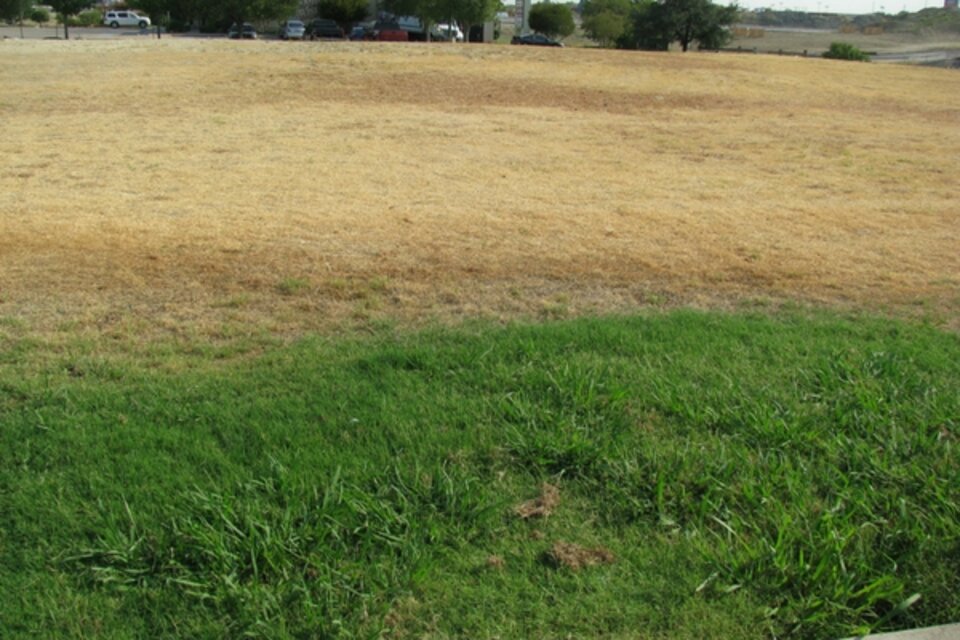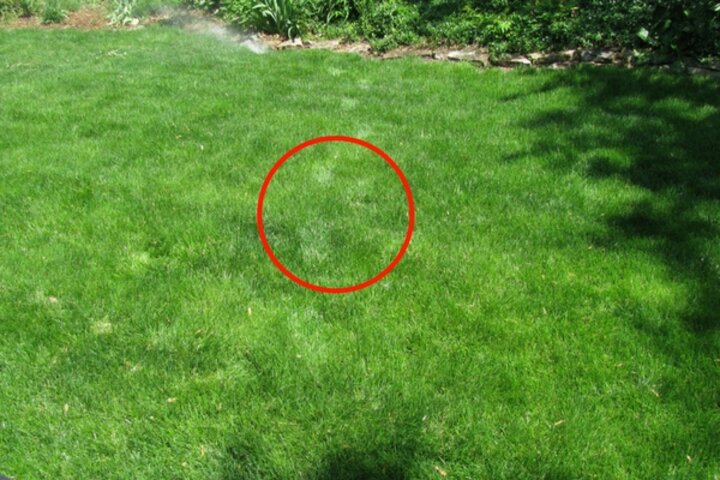Turf Care Under the Hot Sun

Following are effective strategies for managing lawns during periods of hot and dry weather:
1. Learn to recognize wilting in turf plants. It is relatively easy to recognize wilting on a houseplant. The leaves droop and the stem may wither, and the whole plant may have a “dull” appearance. Because turf plants are much smaller and thinner than houseplants, it is much more difficult to recognize drought stress in turf plants.
The first symptom is a bluish cast to the leaf blades. This is subtle, but with experience, you can learn to recognize it. Next, walk through the lawn and then look back at your footsteps. If they are easily seen, and don’t spring back into place after an hour, the lawn is probably under drought stress. Third, the plants become thinner, and the grass blades tend to roll up instead of remaining flat. Soil examination is also useful. Probe the soil with a screwdriver or hollow piece of pipe such as electrical conduit. Feel the soil at various levels of root depth to determine the moisture content. The picture below shows footprints in a drought stressed lawn. Notice the footprints in the red circle.

2. Allow dormancy to happen for Kentucky bluegrass and buffalograss lawns. If you completely withhold water, plants will die. However, if you greatly reduce the amount of water applied, the turf plants will stay alive, but go dormant. Dormant grass plants don’t look very attractive, but beauty is not the current priority. In most cases, you can water about one fourth to one third as much as you normally would and keep the plants alive in a dormant or semi-dormant state. Use empty tuna cans to measure the reduced amounts and compare them to normal amounts.
This strategy should not be used for tall fescue or perennial ryegrass. These species lack the rhizomes in the root system which allow the turf to spring back after dormancy.
3. Water for the correct length of time. “How long should you let your irrigation system run?” This is a complicated question, as it is affected by water pressure, size of hose or pipe, wind speed, temperature, nozzle type and age of the system. The key element to strive for is to match the target area with the length of runtime to deliver the necessary amount. If you are allowing the lawn to go dormant, keep the crowns, rhizomes and stolons full of water, then water long enough to deliver about an eighth of an inch. If you are trying keep the lawn green, water until the bottom of the root zone is moist. If the lawn is on a slope, it will be necessary to stop watering once you notice runoff, wait 3 hours, then resume watering. You will need to probe the soil as described in strategy #1 to determine the moisture content of the soil.
4. Reduce fertilization rate. Lots of fertilizer produces lots of growth, which creates lots of leaf surface area to lose water from. Each grass blade has pores, called stomata, which open and close allowing water to escape to the atmosphere. The greater the number of blades, the greater the moisture loss. Use greatly reduced rates of slow release nitrogen fertilizer to keep the turf alive, but does not produce a lot of new shoots. For cool season turfs, late April, early June, early September and early November are good fertilization time frames.
5. Sharpen the mower blade. Keeping the blade sharp will decrease the size of the openings made in each turf blade during mowing. Dull blades tend to rip and tear the grass blades, which create larger openings, and allow more moisture loss.
6. Mow Kentucky bluegrass lawns at a 3 inch mowing height; 3 ½ for tall fescue. These heights are beneficial as they create a “canopy effect” and the lawn benefits from the increased shading. The benefits include reduced evaporation from the soil surface, and a direct relationship between taller shoots and deeper roots.
7. Return clippings back to the lawn. A light sprinkling of grass clippings will act as a mulch for the grass plants, holding in soil moisture, and keeping the crowns cooler. Avoid clumps of clippings which can smother the turf plants. Again this is less of a problem as the drought wears on, because less growth is produced.
8. Designate “hydrozones” in your landscape. Create a maintenance hierarchy between high and low maintenance lawn areas. Mark off a small area for children to play games on and for entertaining and maintain it with regular watering techniques. The bulk of the lawn (if it is bluegrass or buffalograss) can be allowed to go dormant or semi-dormant.
9. Avoid edging the lawn. Edging creates more openings in the turf blades than mowing does and allows greater moisture loss. This procedure is for cosmetic enhancement only, and that is not a high priority in a drought.
10. Reduce traffic on the lawn. Restrict traffic to the high maintenance hydrozone and the patio. Traffic is a stressor, causing bruised grass blades and subsequent moisture loss.
11. Avoid herbicide use. Use of broadleaf herbicides for weed control tend to stress the grass plants a bit, causing them to be weakened. Instead of applying a herbicide, simply pull the weeds or allow them to grow. They can be easily controlled when the drought is over.
This article was reviewed by Nicole Stoner